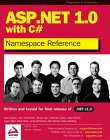| Delphi Clinic | C++Builder Gate | Training & Consultancy | Delphi Notes Weblog | Dr.Bob's Webshop |
| Delphi Clinic | C++Builder Gate | Training & Consultancy | Delphi Notes Weblog | Dr.Bob's Webshop |
| ||||||
 |
Title: Authors: Publisher: ISBN: Info: |
ASP.NET 1.0 with C# Namespace Reference Amit Kalani, John Schenken, Bruce Lee, Matthew Gibbs, Matt Milner, Jason Bell, Mike Clark, Andy Elmhorst, Alex Homer & Dave Gerding WROX 1861007442 930 pages |
This book was written in 2002 and tested against the final release of .NET 1.0.
It is written by 10 different authors, and contains a complete reference to the different ASP.NET namespaces.
Beware, however, that the book is not about writing ASP.NET applications, but rather a helpful reference for ASP.NET developers.
The language and syntax used in the book is C#, but it shouldn't be not hard to "translate" that to Delphi for .NET by the average reader.
The book consists of 11 chapters and 2 appendices.
Since it provides a good idea what the book is all about, the titles of the chapters and appendices are as follows:
|
|

| More Book Reviews |

|
|